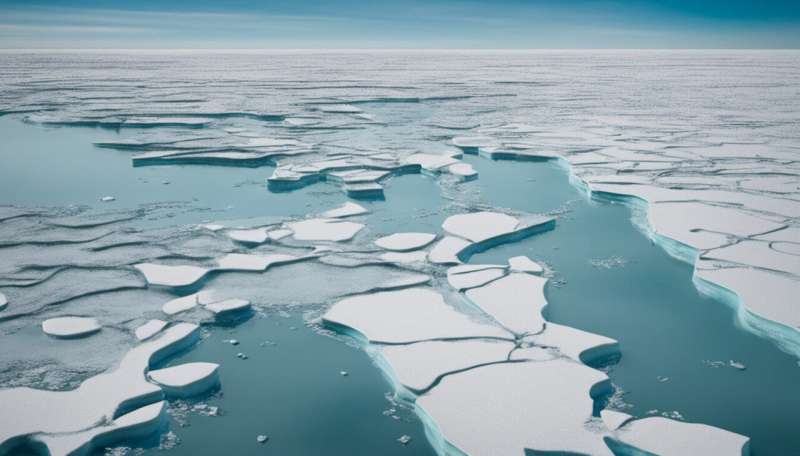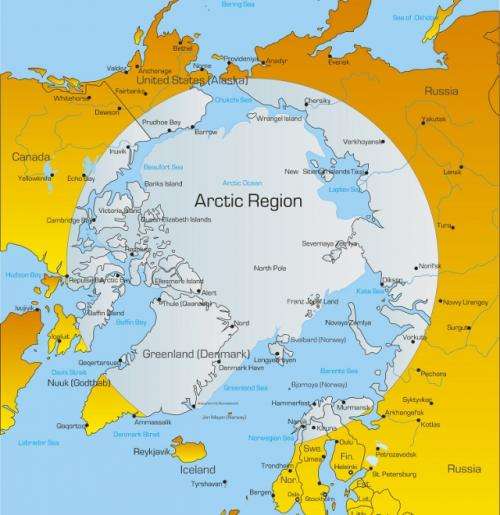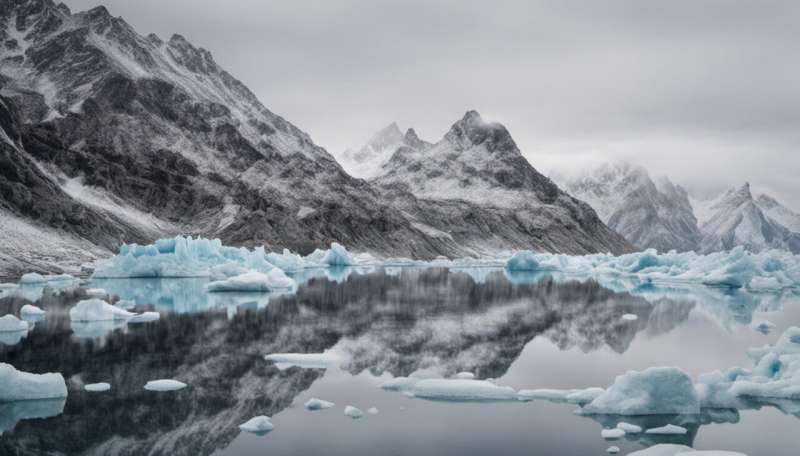Melting ice cap opening shipping lanes and creating conflict among nations

It's July and a cargo ship, laden with some 70,000 tons of coal, is slowly wending its way from Russia to China across the top of the world. This ship is functional, not beautiful; it's longer than two football fields and at least 30 yards wide. As it enters the Kara Sea, north of Russia, the water is scattered with ice floes that are like small islands. With the aid of an icebreaker ship, the cargo ship makes its way steadily under the 24-hour sun to deliver its goods.
In 2004, the possibility of a large commercial tanker crossing the Arctic from Europe to Asia was pretty much nil: even with a trail blazed by sturdy icebreaker ships, dense ice obstructed too much of the route. A decade later, that same journey is almost routine. Rapidly rising temperatures the world over—especially in the northern Arctic zone—now allow some 100 of these mammoth ships to travel the Arctic waters in the summertime, delivering iron ore, coal and other commodities.
The consequences of the Arctic ice melt extend far beyond shorter shipping lanes. The warmer Arctic waters are opening access to oil, gas and mineral deposits for an energy-craving global population and at the same time increasing possibilities for ecotourism. But those same conditions are also eroding the habitats of polar bears and other northern species of land- and sea-dwelling animals and plants, and threatening the way of life of the region's indigenous peoples.
For the United States and the seven other countries with territory in the Arctic—an area of about 13 million square miles—these kinds of changes in a region that has remained relatively pristine for eons could portend potential conflict.
"It would be easy to hypothesize that the ingredients are there for the region to become one of intense competition, if not conflict," says James Stavridis, F83, F84, dean of the Fletcher School at Tufts and former NATO Supreme Allied Commander Europe, whose military duties took him to the Arctic on numerous occasions. "I think the key issue for the U.S. and for the global community is ensuring that the Arctic becomes a zone of cooperation, which I think has high potential if we approach it using tools like diplomacy and coordination among nations."
Oddly enough, the Arctic countries aren't solely defined by latitude. Instead, northern territory that has a median temperature of 50 degrees Fahrenheit or less in July qualifies as Arctic. Eight countries fit the bill: Canada, Denmark (Greenland and the Faroe Islands), Finland, Iceland, Norway, the Russian Federation, Sweden—and the United States.
Alaska makes the United States an Arctic country, "though most Americans don't know it, and most of Congress doesn't know it," says Crocker Snow, F68, director of the Fletcher School's Edward R. Murrow Center for Public Diplomacy. A longtime personal interest in the Arctic—he has family connections in Alaska—led Snow three years ago to begin hosting annual conferences at the Fletcher School to examine the range of issues affecting the region.
The Arctic could become known more for divisive competition for resources and potential environmental disasters than its awe-inspiring natural beauty, Snow says, unless there is careful planning and coordination of activity in the region.
A Sphere of Cooperation
One path to increased cooperation is the Arctic Council, a multinational organization founded in Canada in 1996 by Arctic governments concerned about environmental issues, and now based in Tromsø, Norway. All eight Arctic nations are members, as are "permanent participants" representing the indigenous people in those countries. Observers from countries outside the region also participate because of their interest in natural resources or shipping.
The council operates on a consensus-only basis—all the players have to agree on resolutions. "Everybody involved with the Arctic would say that it's a forum for cooperation and non-confrontation," Snow says. Recent agreements it has brokered are aimed at coordinating search-and-rescue efforts and fishing rights.
The Arctic Council lacks enforcement powers, though. "If things don't translate from the international level to the domestic, national level, then all of the dialogue, debate and agreements arrived at through the Arctic Council mean absolutely nothing," says Dalee Dorough, F91, an associate professor of political science at the University of Alaska who has closely studied the region. "That's where, from my point of view, entities like the Arctic Council need to be strengthened."
Dorough, an Inuit from Alaska, points to the rights of indigenous peoples throughout the region. Their representatives have permanent participant status on the Arctic Council, meaning that they have full consultation rights in connection with the council's negotiations and decisions. But what happens on the ground depends on the political situation in each member country, which varies widely.

For example, Dorough points to Canada's landmark 2005 Labrador-Inuit Land Claim Agreement, which affirmed Inuit rights to broad areas of land and sea as well as their right to self-governance. "They have rights to the land, but they also have a major role in management and co-management in territory and those lands immediately adjacent to their territory," says Dorough, who chairs the U.N. Permanent Forum on Indigenous Issues.
Discover the latest in science, tech, and space with over 100,000 subscribers who rely on Phys.org for daily insights. Sign up for our free newsletter and get updates on breakthroughs, innovations, and research that matter—daily or weekly.
She contrasts the Canadian agreement with less well-defined rights for indigenous peoples in other Arctic nations, and a very basic lack of rights of indigenous people in the Russian Federation. In Russia, the government doesn't recognize the rights of the indigenous peoples to territory or resources; "they are not even on the radar screen," she says.
That said, while the Arctic Council isn't a strong mechanism for multilateral governance of the region, "it is all we've got at the moment, so we ought to invest in that," Stavridis says. "I think the United States should continue to be a strong supporter of the Arctic Council, and I think we should be open to having other nations in it that are not necessarily Arctic nations, but that have key interests, like China, which is a huge economic force, or Greece, which controls a fourth of the world's shipping."
Oil and the Environment
As the ice melts in the Arctic, a rush to extract its natural resources may follow. The U.S. Energy Information Administration estimates that the Arctic contains 13 percent of the world's undiscovered oil resources and 30 percent of the natural gas. The Arctic is also a rich source of nickel, iron ore, copper and rare earth metals used in electronics manufacturing, according to a 2012 report from the Center for Strategic and International Studies that was co-authored by Jamie Kraut, A08, F13.
Nearly 95 percent of the natural resources have already been "spoken for" by one of the eight Arctic Council member countries, Snow says. That's based on provisions in the United Nations Law of the Sea Treaty that mandate ownership of waters 200 miles from the continental shelf of each country's territory. (Other countries extend de facto treaty rights to the United States, which has not signed the treaty; U.S. Senate approval has been blocked for the last 20 years by a handful of senators concerned about giving up sovereignty rights.)
"If we want to take advantage of the enormous hydrocarbons that are present there, which I think ultimately the world will want to do," Stavridis says, "there are two possible outcomes." If carefully managed with ongoing international coordination, he says, it could work well. "But badly managed, it could destroy a very fragile ecosystem."
While the prospects for oil and gas exploration are high, so is the risk of oil spills and environmental disaster. "If you have a serious oil spill in the Arctic, there's a very good chance it's going to be in the dark—in the winter, it's dark 24 hours a day—with very cold weather, and probably offshore," says Snow. "The real fear everybody has is that it will be almost impossible to contain."
He cites a recent example of a very small spill that occurred in February 2011 off the coast of southern Norway and affected Aker Island, a seabird reserve near Oslo. The oil started soaking into the ice, and the Norwegians, who pride themselves on their advanced oil production technology, couldn't easily handle it. When oil is in water, it floats on top, but it penetrates porous ice, and can't be as easily contained and collected as it is in water. "The idea of oil permeating ice in very cold weather, where there's no light at all for rescue crews, it really worries people," Snow says.
And it's not just spills. An increase in mining and tourism could damage the fragile environment. "Even so-called ecotourism can have an impact," Dorough says, noting that when climbers summit Mount McKinley in Alaska's Denali National Park, "a lot of garbage gets left behind."
The tension between economics and the environment also applies to the opening of the Northwest Passage and Northern Sea Route, which large ships traverse in the summer carrying cargo. The benefits are clear. According to a recent report by Kimie Hara, Renison Research Professor in East Asian Studies at the University of Waterloo, published in the Asia-Pacific Journal, "These northern transportation routes can significantly shorten the shipping distance from the Atlantic to the Pacific, from Europe or the east coast of North America to East Asia, making possible reductions in shipping time, fuel costs and CO2 emissions."

"If we want to take advantage of [the Arctic] as a transit route," Stavridis says, "we need to manage it carefully."
In the end, though, it will be the four million people—indigenous and others—who inhabit Arctic nations who will pay the price for development. "This all goes back to the indigenous people in the region," Dorough says. "Development has to be sustainable, and it has to be equitable."
Avoiding a Cold War
Regional politics are critical to development in the Arctic, since policies are implemented at the local, not international, level. Seven of the eight Arctic nations are democracies, and most are NATO members. Then there is the Russian Federation, which has a large stake in the region, operating oil, gas and mineral industries in its territory, and is no doubt interested in more.
During the Cold War, U.S. and Soviet submarines routinely trolled beneath the ice cap north of the Arctic Circle, playing a cat-and-mouse game. "The region was going to be a major battle zone between the U.S. Navy and the Soviet forces," says Stavridis.
Now, of course, conditions are more peaceful—though there are no guarantees. A year ago, Stavridis notes, he would have argued there would always be some tension between Russia and the NATO nations, but that it would be manageable. With the ongoing crisis in Ukraine, friction is clearly rising. "Let's hope we are not stumbling back into a Cold War, no pun intended, in terms of the Arctic," he says. "We need a modus vivendi with Russia that allows us to cooperate in other areas, even as we object and condemn their behavior, appropriately in my view, in Ukraine."
Some countries take a quiet approach to security issues, while others are more strident. "The Canadians always say, 'high north, low tension,' and the Norwegians say, 'This is a border of the alliance; we want NATO involved up here,'" reports Stavridis. The U.S. position lies somewhere between the two. As Stavridis notes, NATO's borders are in the Arctic, and the United States has a leadership role in NATO. Still, in any matters involving the Arctic, the United States "needs to work through international organizations and not try to perform in a unilateral way—that's the wrong approach," he says.
The United States does not have a significant naval presence in the Arctic, and only has two Coast Guard–operated icebreakers. "In terms of the ability to send ships into the high north, it's limited in ice season," which runs from September to May, Stavridis says. By contrast, Russia has more than a dozen icebreakers.
Stavridis says lagging behind the capabilities of other major powers in the Arctic is not wise, pointing out that even China has more icebreakers than the United States. "We should invest more in such ships, so that we can conduct year-round search and rescue, navigational charting, research and development and environmental response," Stavridis wrote in a Foreign Policy article last October.
Building up that capability, Stavridis says, is just one part of what needs to be a multi-pronged approach to the Arctic, which the U.S. must address sooner rather than later. With its natural resources, shipping lanes and political alignments that highlight the differences between NATO nations and Russia, Stavridis says, "the strategic key is ensuring that the Arctic does not become a zone of conflict, and that it remains—at a minimum—a zone of competition, but hopefully becomes a zone of cooperation."
Provided by Tufts University




















